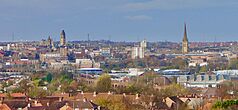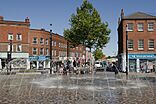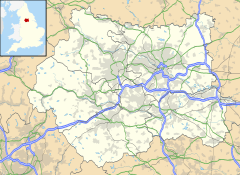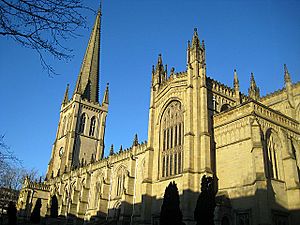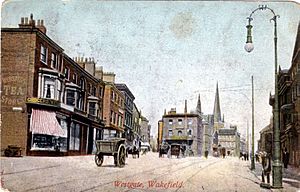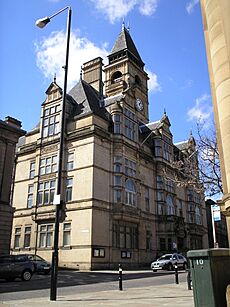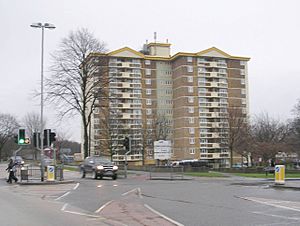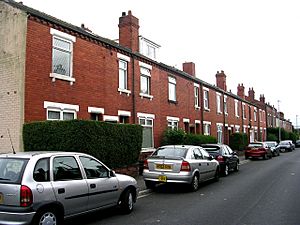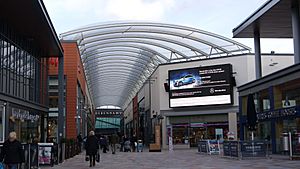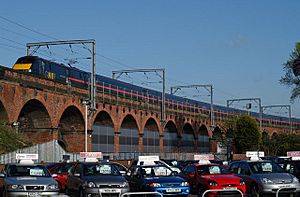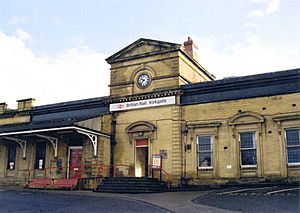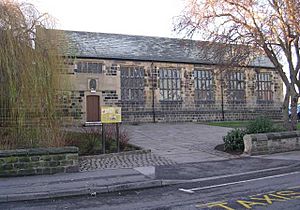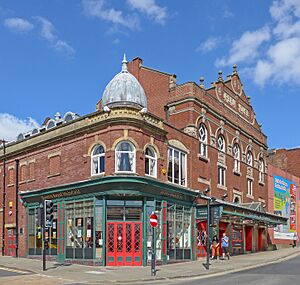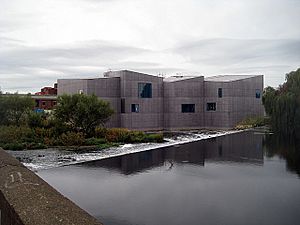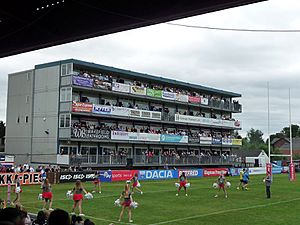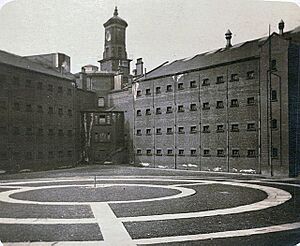Wakefield facts for kids
Quick facts for kids Wakefield |
|
|---|---|
| City | |
|
Wakefield skyline, the Bull Ring square, Town Hall, Cathedral, and Pugneys Country Park (with the town hall and cathedral spire visible) |
|
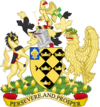 Coat of arms |
|
| Area | 11.3 sq mi (29 km2) |
| Population | 109,767 (2021) |
| • Density | 9,714/sq mi (3,751/km2) |
| OS grid reference | SE335205 |
| • London | 160 mi |
| Metropolitan borough | |
| Metropolitan county | |
| Region | |
| Country | England |
| Sovereign state | United Kingdom |
| Post town | WAKEFIELD |
| Postcode district | WF1-WF4 |
| Dialling code | 01924 |
| Police | West Yorkshire |
| Fire | West Yorkshire |
| Ambulance | Yorkshire |
| EU Parliament | Yorkshire and the Humber |
| UK Parliament |
|
Wakefield is a city in West Yorkshire, England. It sits right by the River Calder. In 2021, about 109,766 people lived in the city. This was more than the 99,251 people who lived there in 2011.
Wakefield became a city in 1888 because of its large church, which is called Wakefield Cathedral. The city has its own town hall. It also has the county hall, which used to be the main office for the wider area.
Important historical events happened here. The Battle of Wakefield took place during the Wars of the Roses. Also, during the Civil War, Wakefield was a strong base for the Royalist side. Over time, Wakefield grew into a key market town. It was famous for trading wool, using the River Calder to move goods. In the 1700s, it also traded in corn, coal, and textiles.
Contents
- Exploring Wakefield's Past
- How Wakefield is Governed
- Wakefield's Location and Climate
- People of Wakefield
- Wakefield's Economy
- Famous Places in Wakefield
- Getting Around Wakefield
- Learning in Wakefield
- Religion in Wakefield
- Culture and Arts in Wakefield
- Sports in Wakefield
- Public Services
- Famous People from Wakefield
- Twin Cities
- Freedom of the City
- See also
Exploring Wakefield's Past
How Wakefield Got Its Name
The name "Wakefield" might come from "Waca's field." This would mean it was open land belonging to someone named "Waca." Another idea is that it came from an old English word, wacu, meaning "a watch or wake." Feld meant an open field where a festival or "wake" was held. In an old book from 1086, called the Domesday Book, the city was written as Wachefeld or Wachefelt.
Early Days of Wakefield
People have lived in the Wakefield area for a very long time. Tools made of flint, stone, bronze, and iron have been found. This shows that humans were here even in prehistoric times. The Brigantes tribe lived here before the Romans arrived in AD 43.
A Roman road used to cross the River Calder near where Wakefield Bridge is now. Later, in the 5th or 6th century, the Angles likely settled here. After AD 876, the Vikings took control. They created many small villages, or thorpes, around Wakefield. The area was divided into sections called wapentakes. Wakefield was part of the Wapentake of Agbrigg.
The town grew where three main roads met: Westgate, Northgate, and Kirkgate. The word "gate" comes from an Old Norse word meaning "road." "Kirk" means "church," so there was a church here early on.
Before 1066, Edward the Confessor owned the land of Wakefield. After the Battle of Hastings, it went to William the Conqueror. In 1069, William took revenge on people in the north who resisted his rule. This event was called the Harrying of the North. Wakefield was affected, and much of the land was described as "waste."
The land was later given to William de Warenne, 1st Earl of Surrey. His family, the Earls Warenne, owned it for many years. Sandal Castle began to be built in the early 12th century.
In 1203, Wakefield was given the right to hold a market. Later, in 1204, King John allowed a fair to be held on November 1st. In 1258, Henry III granted another fair for June 24th. The market was near the Bull Ring and the church. People in Wakefield enjoyed games and sports, which is why it was known as "Merrie Wakefield." Archery was a popular sport in the 14th century.
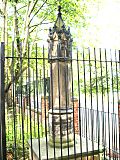
During the Wars of the Roses, Richard Plantagenet, Duke of York was killed near Sandal Castle on December 30, 1460. Later, in the English Civil War, Wakefield was a stronghold for the Royalists. However, on May 20, 1643, Sir Thomas Fairfax led an attack and captured the town for the Parliamentarians. Over 1500 soldiers were taken prisoner.
In medieval times, Wakefield became an important port on the Calder River. It was a center for wool and leather making. In 1699, a law was passed to create the Aire and Calder Navigation. This allowed boats to reach Wakefield from the North Sea. The first office for recording deeds in the country opened here in 1704. By 1765, Wakefield's cattle market was one of the biggest in northern England. The town also had a special hall for selling cloth, called the Tammy Hall, built in 1766.
Wakefield During the Industrial Revolution
By the early 1800s, Wakefield was a rich market town. It traded a lot of wool and grain. The canals, like the Aire and Calder Navigation and Calder and Hebble Navigation, helped Wakefield become a major grain market. More grain was sold here than anywhere else in the north. Large buildings were built along the river to store grain.
The market grew around the Bull Ring. The cattle market became one of the largest in the country. Roads were also important for transport. Mail coaches regularly went to cities like Leeds, London, and Manchester. The 'Strafford Arms' was a famous inn where coaches would stop. Railways arrived in Wakefield in 1840. Kirkgate Station was built on the line from Manchester to Leeds.
As cloth trading slowed down, new wool spinning mills were built by the river. These mills used steam power. Wakefield also had glass works, breweries, and engineering factories. These factories were often linked to the mining industry. There were also soapworks and brickyards. Boats were built in yards along the Calder River.
Coal mining had been happening on the edge of town since the 1400s. By 1831, about 300 men worked in the town's coal pits. More mines were dug in the 1800s. By 1869, there were 46 small mines in and around Wakefield. The National Coal Board became the biggest employer in Wakefield. Some mines, like Manor Colliery and Park Hill colliery, stayed open until 1982.
In the 1800s, Wakefield became the main administrative center for the West Riding of Yorkshire. Many important buildings were constructed then. The court house was built in 1810. The West Riding Pauper Lunatic Asylum was built in 1816. This asylum was very important for the study of mental health in Britain. Most of it has now been taken down.
The old House of Correction from 1595 was rebuilt as Wakefield Prison in 1847. The Wakefield Union workhouse was built in 1853. Clayton Hospital was built in 1854. The Mechanics Institute, which had a public library and newsroom, was built in 1820-1821.
Until 1837, Wakefield got its water from wells and springs. The river water was dirty. New water systems were built, and clean water came from reservoirs starting in 1888. By 1885, the streets were paved and lit with gas.
Wakefield in the 20th Century
On June 2, 1906, a new Wakefield Library opened on Drury Lane. It was built with a grant of £8,000.
After the First World War, the council started building new housing estates. The oldest is Portobello, and the largest is Lupset. Other estates include Flanshaw, Plumpton, Peacock, Eastmoor, and Kettlethorpe. Some of these homes were later sold to the people living in them. Villages like Sandal Magna, Belle Vue, and Agbrigg have now become part of Wakefield.
In the 1970s and 1980s, the glass and textile factories closed. Coal mines also faced problems as demand for coal went down. Many coal mines around Wakefield closed between 1979 and 1983. Some miners moved to new pits that were opening elsewhere.
How Wakefield is Governed
Wakefield was an old market and parish town. It became a parliamentary borough in 1832, meaning it could elect one Member of Parliament. In 1848, Wakefield became a municipal borough with elected councillors.
Wakefield was the main center for government in Yorkshire for 200 years. It became the county headquarters for the West Riding County Council in 1888. When Wakefield became a diocese (a church district) in 1888, the council asked for city status, which was granted that same year. In 1974, Wakefield joined with nearby areas to form the City of Wakefield district.
Today, the city is the main office for the Wakefield Metropolitan District Council. It also houses the Yorkshire Ambulance Service and West Yorkshire Police headquarters. Since 1987, the district council has been based in County Hall.
Wakefield is divided into four areas for local elections: Wakefield East, North, South, and West. Each area elects three councillors to the council.
Wakefield's Location and Climate
Wakefield is about 9 miles (14 km) southeast of Leeds. It is 28 miles (45 km) southwest of York. The city is on the eastern edge of the Pennines mountains, in the lower Calder Valley. The city center is on a small hill on the north side of the Calder River. A 14th-century stone bridge and a newer concrete bridge cross the river here. Wakefield is at a key point where major roads meet, connecting it to cities like Sheffield, Leeds, and Doncaster.
Wakefield is in an area with coal, sandstone, and other rocks formed during the Carboniferous period. The city includes former villages like Alverthorpe, Thornes, Sandal Magna, Agbrigg, Lupset, Kettlethorpe, and Flanshaw.
| Climate data for Wakefield | |||||||||||||
|---|---|---|---|---|---|---|---|---|---|---|---|---|---|
| Month | Jan | Feb | Mar | Apr | May | Jun | Jul | Aug | Sep | Oct | Nov | Dec | Year |
| Mean daily maximum °C (°F) | 7 (44) |
7 (44) |
9 (49) |
12 (53) |
16 (60) |
18 (65) |
21 (69) |
21 (69) |
17 (63) |
13 (56) |
9 (49) |
7 (45) |
13 (56) |
| Mean daily minimum °C (°F) | 2 (36) |
2 (36) |
3 (37) |
4 (39) |
7 (45) |
10 (50) |
12 (54) |
12 (54) |
10 (50) |
7 (45) |
4 (39) |
3 (37) |
6 (44) |
| Average precipitation mm (inches) | 87 (3.41) |
64 (2.50) |
68 (2.67) |
62 (2.46) |
56 (2.19) |
67 (2.63) |
51 (2.01) |
64 (2.50) |
64 (2.53) |
74 (2.91) |
78 (3.06) |
92 (3.62) |
827 (32.49) |
Nearby Towns and Places
 |
Morley | Leeds | Castleford |  |
| Ossett | Pontefract | |||
| Horbury | Barnsley | Ackworth |
People of Wakefield
In 2001, the Wakefield area had a population of 76,886 people. This included 37,477 males and 39,409 females. The wider City of Wakefield district had 315,172 people.
Most people in Wakefield are white (95.7%). About 2.4% are Asian, and 0.5% are Black. These numbers are from 2008. In 2001, 2.53% of residents were born outside the United Kingdom.
Population Changes Over Time
In 2001, Wakefield had 76,886 people. By 2011, the population was 99,251. These numbers are a bit different because the 2011 count included more areas as part of Wakefield.
| Year | 1881 | 1891 | 1901 | 1911 | 1921 | 1931 | 1939 | 1951 | 1961 | ||
|---|---|---|---|---|---|---|---|---|---|---|---|
| Population | 22,173 | 23,315 | 24,107 | 43,588 | 52,891 | 59,122 | 56,963 | 60,371 | 61,268 | ||
|
Wakefield RSD 1881 – 1911 Wakefield MB/CB 1921 – 1961 |
|||||||||||
Wakefield's Economy
The economy of Wakefield changed a lot in the late 1900s. Many coal mines and old factories closed. This led to high unemployment. However, the economy started to get better. Between 1998 and 2003, jobs grew by 12%. This was helped by money from Europe and the UK government.
Manufacturing is still important, but other jobs are growing. Distribution (moving goods) and service industries are now major employers. In 2001, many people worked in retail (shops), manufacturing, health care, and transport.
New Projects and Growth
Wakefield has seen many new projects to improve the city. One big project was Trinity Walk, a shopping center with a department store and supermarket. It opened in 2011. The main square at the Bull Ring was also updated with a water feature. The Ridings Shopping Centre was also improved.
Near the Wakefield Westgate Station, new shops, homes, offices, a car park, and a hotel have been built. A new market hall opened in 2008 but closed in 2018. It is now being turned into an event space called Wakefield Exchange.
The "Wakefield Waterfront" project improved the area by the river and canal. It includes the The Hepworth Wakefield art gallery, which opened in 2011. This gallery is named after local sculptor Barbara Hepworth. It has many of her works and other art. The gallery brought about £10 million to the local economy in its first year. New apartments and offices were also built by the water.
Famous Places in Wakefield
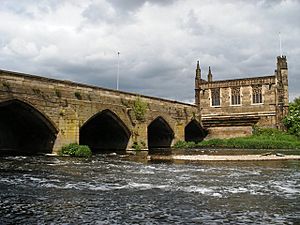
The most famous building in Wakefield is Wakefield Cathedral. Its spire is 247 feet (75 meters) tall, making it the tallest in Yorkshire. Other important buildings on Wood Street include the Crown Court from 1810 and Wakefield Town Hall, which opened in 1880. County Hall from 1898 is also a very old and important building.
The old Wakefield Bridge has a special Chantry Chapel on it. Sandal Castle and Lawe Hill are also ancient historical sites.
Another big structure is the 95-arch railway viaduct. It was built in the 1860s using 800 million bricks. It has a large bridge over Westgate and an iron bridge over the River Calder.
The Ridings Centre, which opened in 1983, was one of the first shopping centers of its kind in the UK. It was used as a model for many others.
Getting Around Wakefield
Wakefield has good connections to major roads. The M1 and M62 motorways are nearby. The city is also crossed by several main roads like the A61 and A638.
Local buses, run by West Yorkshire Metro, serve Wakefield and the surrounding area. Buses are operated by companies like Arriva Yorkshire.
Wakefield has two main train stations. Wakefield Westgate station opened in 1867. From here, you can get trains to Leeds, Doncaster, and London. You can also travel to Newcastle, Edinburgh, and Birmingham. London can be reached in less than two hours.
Wakefield Kirkgate railway station opened in 1840. Trains from here go to Barnsley, Sheffield, Pontefract, and Nottingham. This station has been renovated recently.
The closest airport is Leeds Bradford Airport, which is about 19 miles (31 km) north of the city.
The Aire and Calder Navigation is a canal system that connects Wakefield to Leeds and Goole. It opened to Wakefield in 1706. It is still used by some boats and for leisure. The Calder and Hebble Navigation also connects Wakefield to other towns. The Barnsley Canal, which connected Barnsley to Wakefield, closed in 1953.
Learning in Wakefield
Wakefield's oldest school is Queen Elizabeth Grammar School. It's a boys-only school started in 1591 by Queen Elizabeth I. The original building is now the Elizabethan Gallery. The school moved to Northgate in 1854.
The same group that ran QEGS also opened Wakefield Girls' High School in 1878. Both of these are now independent schools. Other schools, like St Mary's and St John's, were opened by the Church of England. St Austin's Catholic School opened around 1838.
Wakefield College is a big college that offers education for students after high school. It has about 3,000 full-time students and 10,000 part-time students. The college has campuses in the city and nearby towns.
Religion in Wakefield
| Religion in Wakefield 2001 | |||
|---|---|---|---|
| UK Census 2001 | Wakefield | Yorkshire | England |
| Christian | 78.21% | 73.07% | 71.74% |
| No religion | 11.74% | 14.09% | 14.59% |
| Muslim | 1.14% | 3.81% | 3.1% |
| Buddhist | 0.10% | 0.14% | 0.28% |
| Hindu | 0.20% | 0.32% | 1.11% |
| Jewish | 0.04% | 0.23% | 0.52% |
| Sikh | 0.08% | 0.38% | 0.67% |
| Other religions | 0.18% | 0.19% | 0.29% |
| Religion not stated | 7.57% | 7.77% | 7.69% |
Wakefield's oldest church is All Saints, which is now Wakefield Cathedral. It was built in the 14th century on the site of even older churches. It became a cathedral in 1888.
The Chantry Chapel of St Mary the Virgin was built on Wakefield bridge in 1356. This chapel is one of the oldest and most beautiful of its kind still standing in England.
Wakefield is also known for the Wakefield Cycle. This is a collection of 32 old plays from the 14th century. They were performed during a summer religious festival.
St John's Church was built in 1795. Many other churches were built in the 1800s, including St Peter at Stanley, St Paul at Alverthorpe, and St James at Thornes.
The Church of England diocese of Wakefield used to cover many parishes in West Yorkshire. It was closed in 2014. Now, the Diocese of Leeds covers Wakefield.
Wakefield has two Catholic parishes: St Martin de Porres and St Peter and St Paul's. There is also a mosque in Wakefield, the Zakaria Masjid Mosque.
Culture and Arts in Wakefield
The Theatre Royal Wakefield on Westgate opened in 1894. It shows musicals, plays, live music, comedy, and dance.
Wakefield's two main libraries moved into a new building called Wakefield One in 2012. The new library was opened by singer Jarvis Cocker. The Wakefield Museum also moved into Wakefield One at the same time. The museum was officially opened by Sir David Attenborough in 2013.
In 2011, The Hepworth Wakefield art gallery opened by the River Calder. It shows art by local artists Barbara Hepworth and Henry Moore, as well as other artists. It is one of the largest new art galleries built in the UK since 1968.
Wakefield has three parks that are connected: Clarence Park, Holmefield Park, and Thornes Park. They form Wakefield Park. The Clarence Park Music Festival is held there every year, showing local bands.
Wakefield's newspaper, the Wakefield Express, started in 1852. Local news and TV shows are provided by BBC Yorkshire and ITV Yorkshire. Local radio stations include BBC Radio Leeds and Greatest Hits Radio West Yorkshire.
Wakefield is known as the capital of the Rhubarb Triangle. This is an area famous for growing early forced rhubarb. In 2005, a sculpture was put up to celebrate this. There is also an annual "Wakefield Festival of Food, Drink and Rhubarb" in February.
The West Riding Registry of Deeds on Newstead Road holds old records for the area.
In 1913, the Picture House cinema opened in Westgate. It later became the Playhouse and then part of the Classic cinema chain. It is now a nightclub. The Regal Cinema opened in Kirkgate in 1935. It later became the ABC and then a Cannon cinema. It was taken down in 2023.
The famous band The Beatles played at the ABC Cinema in Wakefield on February 7, 1963. This was their only performance in Wakefield.
Wakefield in Films and TV
- The 1963 film This Sporting Life was partly filmed in Wakefield. It used places like the Wakefield Trinity Rugby Ground and parts of Westgate. The writer of the film, David Storey, was born in Wakefield.
- The 1996 film Brassed Off was partly filmed at The National Coal Mining Museum in Wakefield.
- The 2018 TV series The ABC Murders was partly filmed at St Johns Baptist's Church and St John's Square.
Sports in Wakefield
Wakefield Trinity is a Rugby League club. They play in the Super League. The club started in 1873. They play at Belle Vue stadium. Many local amateur teams also play rugby league.
Rugby Union Football is played at Sandal RUFC.
Wakefield briefly had a football team called Emley F.C. that played at Belle Vue. However, the club later moved out of the city and eventually stopped playing in 2014. A new club, Wakefield A.F.C., was formed in 2019. They played in Wakefield for one season in 2023 but then moved out again.
Wakefield Hockey Club and Slazenger Hockey Club play field hockey.
Wakefield Sports Club at College Grove has the Yorkshire Regional Hockey Academy, a bowls club, and a squash club.
The Wakefield Archers meet at QEGS or Slazengers Sports Club. They shoot different types of bows. Thornes Park Athletics Stadium is home to Wakefield Harriers A.C.
There is a 100-acre (0.40 km2) lake at Pugneys Country Park. It is used for water sports like canoeing, sailing, and windsurfing. Golf clubs include the public course at Lupset and the private Wakefield Golf Club at Sandal.
Public Services
Wakefield Prison is a maximum security prison. It was first built as a house of correction in 1594. The West Yorkshire Police force patrols Wakefield. The city is also home to the West Yorkshire Police Headquarters. Fire and rescue services are provided by the West Yorkshire Fire and Rescue Service.
Hospital services are provided by the Mid Yorkshire Hospitals NHS Trust. Local health services like doctors and nurses are managed by Wakefield District Primary Care Trust. The local council handles waste management. Yorkshire Water manages the city's drinking water and wastewater.
Famous People from Wakefield
- Novelist George Gissing was born in Wakefield in 1857. You can visit his childhood home.
- Sculptor Barbara Hepworth was born in Wakefield in 1903. The art gallery, The Hepworth Wakefield, is named after her.
- David Storey, born in Wakefield in 1933, was a writer. His book This Sporting Life was made into a film that was shot in the city.
- Anne Treisman (1935–2018), a psychologist, was born in Wakefield.
- Former Archbishop of York, David Hope, Baron Hope of Thornes, was born in Thornes in 1940.
- Singer Jane McDonald was born in Wakefield in 1963.
- Politician John Leech was born in Wakefield in 1971.
Twin Cities
Wakefield is twinned with several cities around the world:
- Alfeld (Leine), Germany (since 1958)
- Castres, France (since 1953)
- Castrop-Rauxel, Germany (since 1949)
- Girona, Spain (since 1990)
- Hénin-Beaumont, France (since 1972)
- Herne, Germany (since 1956)
- Konin, Poland (since 1996)
Wakefield used to be twinned with Xiangyang, China, and Nanning, China, but these agreements ended. It was also twinned with Belgorod, Russia, but this ended in 2022 because of the invasion of Ukraine.
Freedom of the City
Some people and military groups have been given the "Freedom of the City" of Wakefield. This is a special honor.
Individuals
- Field Marshal Lord Montgomery of Alamein: 4 November 1947.
- James Benjamin Sykes: 18 May 1864.
Military Units
- The King's Own Yorkshire Light Infantry: 1945.
- The Yorkshire Regiment: 13 March 2010.
- The Rifles: 11 September 2010.
See also
 In Spanish: Wakefield para niños
In Spanish: Wakefield para niños


